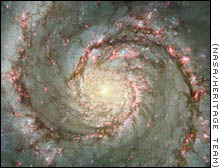According to the researchers' estimates, the age of the galaxy's core is about 400 million years and its mass is 40 million times greater than the mass of our Sun

New images from the Hubble Space Telescope reveal incredible details about one of the most spectacular galaxies - M51, also known as the "Whirlpool Galaxy".
The Whirlpool Galaxy is considered the most photogenic of the many galaxies scattered in space. Its celestial beauty has been extensively studied by a variety of observatories located both on Earth and in space bases.
The photographs from the Hubble Space Telescope allowed the researchers to see an unprecedented detail - the spiral arms and stardust clouds of M51, which are the sites of the formation of large and luminous stars.
In one of the photographs, which is a composite of several observations, you can see starlight, as well as light from phosphorescent hydrogen, which the researchers attribute to new stars, which stand out in their light in the spiral arms. The new images also reveal a ring of stardust at the heart of the galaxy. Astronomers speculate that this stardust provides a kind of "fuel" for a central black hole.
Several groups of astronomers also study the infrared wavelengths, which can be observed with the Hubble telescope, using special detectors. At the wavelengths observed, the stardust clouds appear clearer and the true distribution of the stars in the galaxy can be seen more easily. Apart from this, the regions of star formation that were so far obscured were clearly revealed in the new images.
The heart of the galaxy, which appears as a bright ball of light in the center of the image, is 80 light years away and astronomers estimate that the intensity of its light is about one hundred million suns. According to the researchers' estimates, the age of the galaxy's core is about 400 million years and its mass is 40 million times greater than the mass of our Sun. The concentration of stars in the vortex galaxy and their density is 5,000 times greater than that in our solar system.
